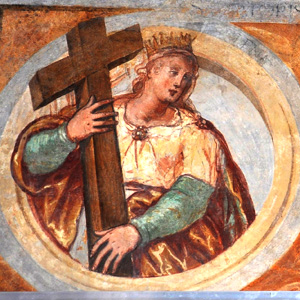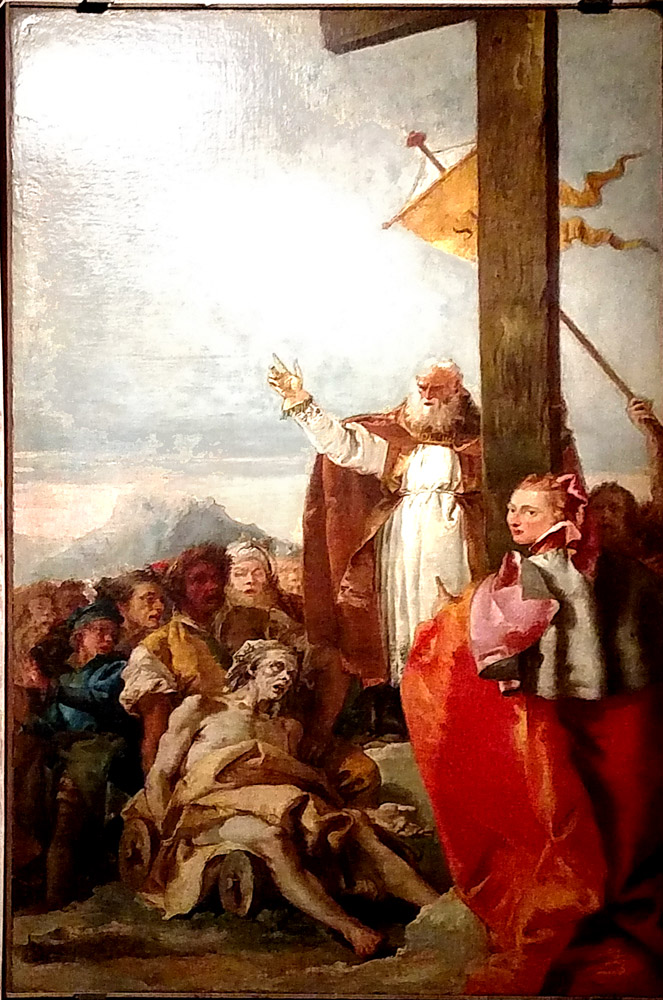On the basis of these historical facts, the Church History written by Rufinus in 402 claimed that it was Helena who did the clearing at Golgotha and during excavations found three crosses. At Macarius' suggestion he and Helena took the crosses to a woman who was lying sick and touched each of the crosses to her in turn. At the touch of the third cross "she began to run about all over the house magnifying the power of the Lord" (Head, 85). This verified the identity of the True Cross, and Helena built the Church of the Holy Sepulcher on the site where the Cross had been found.
The 5th century saw a Greek retelling of the story, soon translated into Latin under the title Vita Cyriaci. The latter is the basis of most western accounts of Helena's sojourn in Jerusalem.2 In these accounts the historical Macarius disappears and a Jew named Judas is introduced who warns his coreligionists that their faith will be destroyed if Helena finds the cross, because so much of the Christian story is true.
In fact no Jews were allowed to enter Jerusalem in the 4th century,3 but Judas' speech is just the first shot in the antisemitic barrage of this story. Helena convenes the Jews and demands that they tell her where the cross is buried on pain of death. Fearing her threats to destroy the entire city, they deliver Judas, who seems to know something. He feigns ignorance and is thrown into a pit for seven days. At last he prays to God to reveal the hiding place "if it is your will for the son of Mary to reign" (si tua voluntas est regnare filium Mariae, Vita Cyriaci, 447). Then a column of smoke reveals the place and Judas digs up three crosses. At this moment he sees people carrying the body of a dead youth on a bier. Like Macarius with the ailing woman, he touches the three crosses in turn to the body and verifies the third one as the True Cross when the youth rises to life. Judas then converts to Christianity. Later he becomes Bishop of Jerusalem under the name Cyriacus and in that capacity leads a group that digs up the "Holy Nails" that were used in the Crucifixion.
NARRATIVE IMAGES
The story of Helena and Judas appears in a number of media throughout the middle ages. Like the predella panels listed at right, the images often present in serial format Helena's convening of the Jews, the unearthing of the three crosses, and the resuscitation of the dead man. Examples include the Stavelot Reliquary. There are also single-scene images that celebrate the resuscitation together with the lifting of the cross on high. (example). This lifting or "Exaltation" of the Cross is celebrated on September 14.PORTRAITS
The primary attribute of St. Helena is a standing wooden cross, usually taller than the saint but not quite tall enough to actually hold a crucified man, as in the painting at right. Her portrait in a window at Regensburg Cathedral has her holding only a small fragment of the cross, about the size of a small scepter (Whiteside, 76). A second attribute is a crown, referring to her status as mother of the Emperor.A figure resembling Helena is portrayed in two martyrdom paintings in the Franciscan museum in Dubrovnik. In one of them, as St. Lawrence rises to Heaven from the gridiron below he hands his palm of martyrdom to a woman who is seated on a cloud, holding a tall wooden cross and reclining on what appears to be a model of the Church of the Holy Sepulcher. This would seem to be Helena, but there is no crown, and Lawrence predeceased the empress by many years.
In the other painting, it is St. George who ascends toward the woman on the cloud. She extends her right hand to his and points up to Heaven with her left. On her left a putto holds a wooden cross. Again, this is a martyr who died before Helena's time, so why would she be at Heaven's gate to welcome him?
These female figures are probably not the Virgin: they do not wear blue, are not crowned, and are not enthroned beside Christ. And it seems a stretch to see them allegorically as the Church, because of their transitional location in the heavens.
Prepared in 2014 by Richard Stracke, Emeritus Professor of English, Augusta University
HOME PAGE

A fresco in the Church of St. Justina in Padua. (See the description page.)

Tiepolo's Saints Helen and Macarius Find the True Cross returns Macarius to the story and makes the sick person a man. (See description page)
ATTRIBUTES
- A large cross
- A crown
FOUR NARRATIVE IMAGES FROM A PREDELLA
- Helena summons the Jews to a Council
- Judas is Confined to a Pit
- The three crosses are unearthed
- The Resuscitation of the Dead Man
MORE IMAGES
- 1426-28: Ferrara, The Invention of the True Cross in Urbino, Italy.
- 16th century: Garofalo's Identification of the True Cross pictures the resuscitation of the sick man.
- 17th century: Guercino's so-called Invention of the Holy Cross has Helena and Macarius praying as a workman lifts the cross on high.
- 17th-18th century: Sebastiano Ricci's painting celebrates both the Invention and the Exaltation of the Cross.
- Undated: This "Exaltation" includes the man who has been recalled to life.
- Undated: Helena having a Vision of the Presentation in the Temple.
- Undated: Helena with St. Francis and the Cross.
- Undated: Helena holding the Holy Nails while she worships the Cross.
DATES
- Helena lived circa 250-330.
- Feast day: August 18
- The "Invention" or finding of the Cross is celebrated on May 8.
- The feast of the "Exaltation [lifting up] of the Holy Cross" is celebrated on September 14.
BIOGRAPHY
-
Golden Legend #68: html or pdf
- Rufinus, Church History: relevant chapters translated in Head, 83-86.
- The Roman Breviary for May 3, Invention of the Holy Cross: English translation, II, 849-50; Latin original, 859-65.
-
The Vita Cyriaci is in Acta Sanctorum, May vol. 1, 445-48. On it are based:
— The Inventio Sanctae Crucis, translated in Head (86-92)
— The Anglo-Saxon Elene (Original in Krapp and Dobbie, II, 66-102, translation in Kennedy)
— The account in the South English Legendary (1-5).
NOTES
1 Head 77-79.
2 A notable exception is the Roman Breviary (English translation: II, 850), which reverts to Rufinus's Church History, in which the helpful local is Macarius and the True Cross is revealed by the cure of an ailing woman rather than by the revival of a dead youth.
3 The 1914 Catholic Encyclopedia, s.v. "Jerusalem (A.D. 71-1099)," ¶5. Wikipedia s.v. "Aelia Capitolina," Both retrieved 2014-01-07.